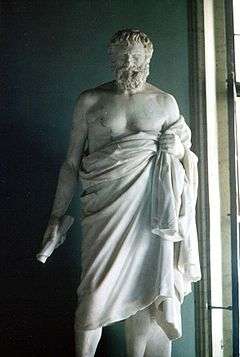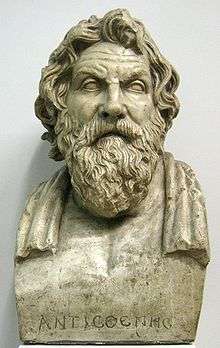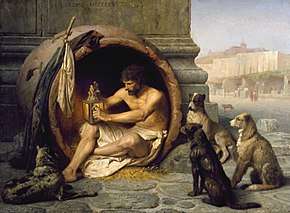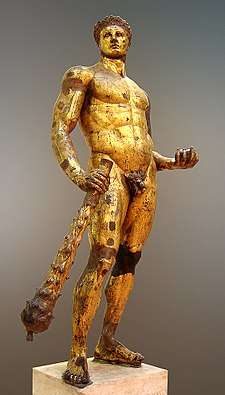Cynicism (philosophy)
Cynicism (Ancient Greek: κυνισμός) is a school of thought of ancient Greek philosophy as practiced by the Cynics (Ancient Greek: Κυνικοί, Latin: Cynici). For the Cynics, the purpose of life is to live in virtue, in agreement with nature. As reasoning creatures, people can gain happiness by rigorous training and by living in a way which is natural for themselves, rejecting all conventional desires for wealth, power, and fame. Instead, they were to lead a simple life free from all possessions.

The first philosopher to outline these themes was Antisthenes, who had been a pupil of Socrates in the late 5th century BC. He was followed by Diogenes, who lived in a ceramic jar on the streets of Athens.[2] Diogenes took Cynicism to its logical extremes, and came to be seen as the archetypal Cynic philosopher. He was followed by Crates of Thebes, who gave away a large fortune so he could live a life of Cynic poverty in Athens.
Cynicism gradually declined in importance after the 3rd century BC,[3] but it experienced a revival with the rise of the Roman Empire in the 1st century. Cynics could be found begging and preaching throughout the cities of the empire, and similar ascetic and rhetorical ideas appeared in early Christianity. By the 19th century, emphasis on the negative aspects of Cynic philosophy led to the modern understanding of cynicism to mean a disposition of disbelief in the sincerity or goodness of human motives and actions.
Origin of the Cynic name
The name Cynic derives from Ancient Greek κυνικός (kynikos), meaning 'dog-like', and κύων (kyôn), meaning 'dog' (genitive: kynos).[4] One explanation offered in ancient times for why the Cynics were called "dogs" was because the first Cynic, Antisthenes, taught in the Cynosarges gymnasium at Athens.[5] The word cynosarges means the "place of the white dog". It seems certain, however, that the word dog was also thrown at the first Cynics as an insult for their shameless rejection of conventional manners, and their decision to live on the streets. Diogenes, in particular, was referred to as the "Dog",[6] a distinction he seems to have revelled in, stating that "other dogs bite their enemies, I bite my friends to save them."[7] Later Cynics also sought to turn the word to their advantage, as a later commentator explained:
There are four reasons why the Cynics are so named. First because of the indifference of their way of life, for they make a cult of indifference and, like dogs, eat and make love in public, go barefoot, and sleep in tubs and at crossroads. The second reason is that the dog is a shameless animal, and they make a cult of shamelessness, not as being beneath modesty, but as superior to it. The third reason is that the dog is a good guard, and they guard the tenets of their philosophy. The fourth reason is that the dog is a discriminating animal which can distinguish between its friends and enemies. So do they recognize as friends those who are suited to philosophy, and receive them kindly, while those unfitted they drive away, like dogs, by barking at them.[8]
Philosophy
Cynicism is one of the most striking of all the Hellenistic philosophies.[9] It claimed to offer people the possibility of happiness and freedom from suffering in an age of uncertainty. Although there was never an official Cynic doctrine, the fundamental principles of Cynicism can be summarized as follows:[10][11]
- The goal of life is eudaimonia and mental clarity or lucidity (ἁτυφια) - literally "freedom from smoke (τύφος)" which signified false belief, mindlessness, folly, and conceit.
- Eudaimonia is achieved by living in accord with Nature as understood by human reason.
- Arrogance (τύφος) is caused by false judgments of value, which cause negative emotions, unnatural desires, and a vicious character.
- Eudaimonia, or human flourishing, depends on self-sufficiency (αὐτάρκεια), equanimity, arete, love of humanity, parrhesia, and indifference to the vicissitudes of life (adiaphora ἁδιαφορία).
- One progresses towards flourishing and clarity through ascetic practices (ἄσκησις) which help one become free from influences – such as wealth, fame, and power – that have no value in Nature. Examples include Diogenes' practice of living in a tub and walking barefoot in winter.
- A Cynic practices shamelessness or impudence (Αναιδεια) and defaces the nomos of society; the laws, customs, and social conventions which people take for granted.
Thus a Cynic has no property and rejects all conventional values of money, fame, power and reputation.[10] A life lived according to nature requires only the bare necessities required for existence, and one can become free by unshackling oneself from any needs which are the result of convention.[15] The Cynics adopted Heracles as their hero, as epitomizing the ideal Cynic.[13] Heracles "was he who brought Cerberus, the hound of Hades, from the underworld, a point of special appeal to the dog-man, Diogenes."[14] According to Lucian, "Cerberus and Cynic are surely related through the dog."[16]
The Cynic way of life required continuous training, not just in exercising judgments and mental impressions, but a physical training as well:
[Diogenes] used to say, that there were two kinds of exercise: that, namely, of the mind and that of the body; and that the latter of these created in the mind such quick and agile impressions at the time of its performance, as very much facilitated the practice of virtue; but that one was imperfect without the other, since the health and vigour necessary for the practice of what is good, depend equally on both mind and body.[17]
None of this meant that a Cynic would retreat from society. Cynics were in fact to live in the full glare of the public's gaze and be quite indifferent in the face of any insults which might result from their unconventional behaviour.[10] The Cynics are said to have invented the idea of cosmopolitanism: when he was asked where he came from, Diogenes replied that he was "a citizen of the world, (kosmopolitês)."[18]
The ideal Cynic would evangelise; as the watchdog of humanity, they thought it their duty to hound people about the error of their ways.[10] The example of the Cynic's life (and the use of the Cynic's biting satire) would dig up and expose the pretensions which lay at the root of everyday conventions.[10]
Although Cynicism concentrated primarily on ethics, some Cynics, such as Monimus, addressed epistemology with regard to tuphos (τῦφος) expressing skeptical views.
Cynic philosophy had a major impact on the Hellenistic world, ultimately becoming an important influence for Stoicism. The Stoic Apollodorus, writing in the 2nd century BC, stated that "Cynicism is the short path to virtue."[19]
History of Cynicism

The classical Greek and Roman Cynics regarded virtue as the only necessity for happiness, and saw virtue as entirely sufficient for attaining it. Classical Cynics followed this philosophy to the extent of neglecting everything not furthering their perfection of virtue and attainment of happiness, thus, the title of Cynic, derived from the Greek word κύων (meaning "dog") because they allegedly neglected society, hygiene, family, money, etc., in a manner reminiscent of dogs. They sought to free themselves from conventions; become self-sufficient; and live only in accordance with nature. They rejected any conventional notions of happiness involving money, power, and fame, to lead entirely virtuous, and thus happy, lives.[20]
The ancient Cynics rejected conventional social values, and would criticise the types of behaviours, such as greed, which they viewed as causing suffering. Emphasis on this aspect of their teachings led, in the late 18th and early 19th centuries,[21] to the modern understanding of cynicism as "an attitude of scornful or jaded negativity, especially a general distrust of the integrity or professed motives of others."[22] This modern definition of cynicism is in marked contrast to the ancient philosophy, which emphasized "virtue and moral freedom in liberation from desire."[23]
Influences
Various philosophers, such as the Pythagoreans, had advocated simple living in the centuries preceding the Cynics. In the early 6th century BC, Anacharsis, a Scythian sage, had combined plain living together with criticisms of Greek customs in a manner which would become standard among the Cynics.[24] Perhaps of importance were tales of Indian philosophers, known as gymnosophists, who had adopted a strict asceticism. By the 5th century BC, the sophists had begun a process of questioning many aspects of Greek society such as religion, law and ethics. However, the most immediate influence for the Cynic school was Socrates. Although he was not an ascetic, he did profess a love of virtue and an indifference to wealth,[25] together with a disdain for general opinion.[26] These aspects of Socrates' thought, which formed only a minor part of Plato's philosophy, became the central inspiration for another of Socrates' pupils, Antisthenes.
Symbolisms
Cynics were often recognized in the ancient world by their apparel—an old cloak and a staff. The cloak came as an allusion to Socrates and his manner of dress, while the staff was to the club of Heracles. These items became so symbolic of the Cynic vocation that ancient writers accosted those who thought that donning the Cynic garb would make them suited to the philosophy.[27]
In the social evolution from the archaic age to the classical, the public ceased carrying weapons into the poleis. Originally it was expected that one carried a sword while in the city; However, a transition to spears, and then to staffs occurred until wearing any weapon in the city became a foolish old custom.[28] Thus, the very act of carrying a staff was slightly taboo itself. According to modern theorists, the symbol of the staff was one which both functions as a tool to signal the user's dissociation from physical labour, that is, as a display of conspicuous leisure, and at the same time it also has an association with sport and typically plays a part in hunting and sports clothing. Thus, it displays active and warlike qualities, rather than being a symbol of a weak man's need to support himself.[29][30] The staff itself became a message of how the Cynic was free through its possible interpretation as an item of leisure, but, just as equivalent, was its message of strength - a virtue held in abundance by the Cynic philosopher.
Antisthenes
The story of Cynicism traditionally begins with Antisthenes (c. 445–365 BC),[31][32] who was an older contemporary of Plato and a pupil of Socrates. About 25 years his junior, Antisthenes was one of the most important of Socrates' disciples.[33] Although later classical authors had little doubt about labelling him as the founder of Cynicism,[34] his philosophical views seem to be more complex than the later simplicities of pure Cynicism. In the list of works ascribed to Antisthenes by Diogenes Laërtius,[35] writings on language, dialogue and literature far outnumber those on ethics or politics,[36] although they may reflect how his philosophical interests changed with time. It is certainly true that Antisthenes preached a life of poverty:
I have enough to eat till my hunger is stayed, to drink till my thirst is sated; to clothe myself as well; and out of doors not [even] Callias there, with all his riches, is more safe than I from shivering; and when I find myself indoors, what warmer shirting do I need than my bare walls?[38]
Diogenes of Sinope

Diogenes (c. 412–323 BC) dominates the story of Cynicism like no other figure. He originally went to Athens, fleeing his home city, after he and his father, who was in charge of the mint at Sinope, got into trouble for falsifying the coinage.[39] (The phrase "defacing the currency" later became proverbial in describing Diogenes' rejection of conventional values.)[40] Later tradition claimed that Diogenes became the disciple of Antisthenes,[41] but it is by no means certain that they ever met.[42][43][44] Diogenes did however adopt Antisthenes' teachings and the ascetic way of life, pursuing a life of self-sufficiency (autarkeia), austerity (askēsis), and shamelessness (anaideia).[45] There are many anecdotes about his extreme asceticism (sleeping in a tub),[46] his shameless behaviour (eating raw meat),[47] and his criticism of conventional society ("bad people obey their lusts as servants obey their masters"),[48] and although it is impossible to tell which of these stories are true, they do illustrate the broad character of the man, including an ethical seriousness.[49]
Crates of Thebes
Crates of Thebes (c. 365–c. 285 BC) is the third figure who dominates Cynic history. He is notable because he renounced a large fortune to live a life of Cynic poverty in Athens.[50] He is said to have been a pupil of Diogenes,[51] but again this is uncertain.[52] Crates married Hipparchia of Maroneia after she had fallen in love with him and together they lived like beggars on the streets of Athens,[53] where Crates was treated with respect.[54] Crates' later fame (apart from his unconventional lifestyle) lies in the fact that he became the teacher of Zeno of Citium, the founder of Stoicism.[55] The Cynic strain to be found in early Stoicism (such as Zeno's own radical views on sexual equality spelled out in his Republic) can be ascribed to Crates' influence.[56]
Other Cynics
There were many other Cynics in the 4th and 3rd centuries BC, including Onesicritus (who sailed with Alexander the Great to India), the skeptic Monimus, the moral satirist Bion of Borysthenes, the diatribist Teles and Menippus of Gadara. However, with the rise of Stoicism in the 3rd century BC, Cynicism as a serious philosophical activity underwent a decline,[3][57] and it is not until the Roman era that Cynicism underwent a revival.
Cynicism in the Roman world

There is little record of Cynicism in the 2nd or 1st centuries BC; Cicero (c. 50 BC), who was much interested in Greek philosophy, had little to say about Cynicism, except that "it is to be shunned; for it is opposed to modesty, without which there can be neither right nor honor."[58] However, by the 1st century AD, Cynicism reappeared with full force. The rise of Imperial Rome, like the Greek loss of independence under Philip and Alexander three centuries earlier, may have led to a sense of powerlessness and frustration among many people, which allowed a philosophy which emphasized self-sufficiency and inner-happiness to flourish once again.[59] Cynics could be found throughout the empire, standing on street corners, preaching about virtue.[60] Lucian complained that "every city is filled with such upstarts, particularly with those who enter the names of Diogenes, Antisthenes, and Crates as their patrons and enlist in the Army of the Dog,"[61] and Aelius Aristides observed that "they frequent the doorways, talking more to the doorkeepers than to the masters, making up for their lowly condition by using impudence."[62] The most notable representative of Cynicism in the 1st century AD was Demetrius, whom Seneca praised as "a man of consummate wisdom, though he himself denied it, constant to the principles which he professed, of an eloquence worthy to deal with the mightiest subjects."[63] Cynicism in Rome was both the butt of the satirist and the ideal of the thinker. In the 2nd century AD, Lucian, whilst pouring scorn on the Cynic philosopher Peregrinus Proteus,[64] nevertheless praised his own Cynic teacher, Demonax, in a dialogue.[65]
Cynicism came to be seen as an idealised form of Stoicism, a view which led Epictetus to eulogise the ideal Cynic in a lengthy discourse.[66] According to Epictetus, the ideal Cynic "must know that he is sent as a messenger from Zeus to people concerning good and bad things, to show them that they have wandered."[67] Unfortunately for Epictetus, many Cynics of the era did not live up to the ideal: "consider the present Cynics who are dogs that wait at tables, and in no respect imitate the Cynics of old except perchance in breaking wind."[68]
Unlike Stoicism, which declined as an independent philosophy after the 2nd century AD, Cynicism seems to have thrived into the 4th century.[69] The emperor, Julian (ruled 361–363), like Epictetus, praised the ideal Cynic and complained about the actual practitioners of Cynicism.[70] The final Cynic noted in classical history is Sallustius of Emesa in the late 5th century.[71] A student of the Neoplatonic philosopher Isidore of Alexandria, he devoted himself to living a life of Cynic asceticism.
Cynicism and Christianity

Jesus as a Jewish Cynic
Some historians have noted the similarities between the teachings of Jesus and those of the Cynics. Some scholars have argued that the Q document, a hypothetical common source for the gospels of Matthew and Luke, has strong similarities to the teachings of the Cynics.[73][74] Scholars on the quest for the historical Jesus, such as Burton L. Mack and John Dominic Crossan of the Jesus Seminar, have argued that 1st-century AD Galilee was a world in which Hellenistic ideas collided with Jewish thought and traditions. The city of Gadara, only a day's walk from Nazareth, was particularly notable as a centre of Cynic philosophy,[75] and Mack has described Jesus as a "rather normal Cynic-type figure."[76] For Crossan, Jesus was more like a Cynic sage from a Hellenistic Jewish tradition than either a Christ who would die as a substitute for sinners or a messiah who wanted to establish an independent Jewish state of Israel.[77] Other scholars doubt that Jesus was deeply influenced by the Cynics and see the Jewish prophetic tradition as of much greater importance.[78]
Cynic influences on early Christianity
Many of the ascetic practices of Cynicism may have been adopted by early Christians, and Christians often employed the same rhetorical methods as the Cynics.[79] Some Cynics were martyred for speaking out against the authorities.[80] One Cynic, Peregrinus Proteus, lived for a time as a Christian before converting to Cynicism,[81] whereas in the 4th century, Maximus of Alexandria, although a Christian, was also called a Cynic because of his ascetic lifestyle. Christian writers would often praise Cynic poverty,[82] although they scorned Cynic shamelessness: Augustine stating that they had, "in violation of the modest instincts of men, boastfully proclaimed their unclean and shameless opinion, worthy indeed of dogs."[83] The ascetic orders of Christianity also had direct connection with the Cynics, as can be seen in the wandering mendicant monks of the early church who in outward appearance, and in many of their practices differed little from the Cynics of an earlier age.[72]
See also
- Anticonformism
- Asceticism
- Cynic epistles
- Encratites
- Foolishness for Christ
- List of ancient Greek philosophers
- List of Cynic philosophers
- Natural law
- Stoicism
- Kotzker Rebbe (a chasidic "Cynic" in the ancient sense of the word)
Notes
- Christopher H. Hallett, (2005), The Roman Nude: Heroic Portrait Statuary 200 BC–AD 300, page 294. Oxford University Press
- Laërtius & Hicks 1925, Ⅵ:23 ; Jerome, Adversus Jovinianum, 2.14.
- Dudley 1937, p. 117
- Kynikos, "A Greek-English Lexicon", Liddell and Scott, at Perseus
- Diogenes Laërtius, vi. 13. Cf. The Oxford Companion to Classical Literature, 2nd edition, p. 165.
- An obscure reference to "the Dog" in Aristotle's Rhetoric (3.10.1411a25) is generally agreed to be the first reference to Diogenes.
- Diogenes of Sinope, quoted by Stobaeus, Florilegium, iii. 13. 44.
- Scholium on Aristotle's Rhetoric, quoted in Dudley 1937, p. 5
- Long 1996, p. 28
- Kidd 2005
- Long 1996, p. 29
- Diogenes Laërtius, vi. 2, 71; Dio Chrysostom, Orations, viii. 26–32; Pseudo-Lucian, Cynicus, 13; Lucian, De Morte Peregrini, 4, 33, 36.
- Orlando Patterson: Freedom. p. 186
- Long 1996, p. 34
- Lucian, Dialogues of the Dead, 21
- Diogenes Laërtius, vi. 70
- Diogenes Laërtius, vi. 63
- Diogenes Laërtius, vii. 121
- Cynics – The Internet Encyclopedia of Philosophy
- David Mazella, (2007), The Making of Modern Cynicism, University of Virginia Press. ISBN 0-8139-2615-7
- Cynicism, The American Heritage Dictionary of the English Language. Fourth Edition. 2006. Houghton Mifflin Company.
- Bertrand Russell, A History of Western Philosophy, page 231. Simon and Schuster.
- R. Martin, The Scythian Accent: Anacharsis and the Cynics, Bracht Branham & Goulet-Cazé 1996
- Plato, Apology, 41e.
- Xenophon, Apology, 1.
- Epictetus, 3.22
- Aristotle, Politics (Aristotle): bk 2, 1268b
- Veblen, 1994[1899]: 162
- Jon Ploug Jørgensen, The taming of the aristoi - an ancient Greek civilizing process? History of the Human Sciences: July 2014 vol. 27 no. 3, pg 42-43
- Dudley 1937, p. 1
- Bracht Branham & Goulet-Cazé 1996, p. 6
- Xenophon, Symposium, 4.57–64.
- Diogenes Laërtius, vi. 2
- Diogenes Laërtius, vi. 15–18
- Prince 2005, p. 79
- Xenophon, Symposium, 4.34.
- Diogenes Laërtius, vi. 20–21
- Diogenes Laërtius, vi. 20, 71
- Diogenes Laërtius, vi. 6, 18, 21; Aelian, x. 16; Epictetus, Discourses, iii. 22. 63
- Long 1996, p. 45
- Dudley 1937, p. 2
- Prince 2005, p. 77
- Sarton, G., Ancient Science Through the Golden Age of Greece, Dover Publications. (1980).
- Diogenes Laërtius, vi. 23; Jerome, Adversus Jovinianum, 2.14
- Diogenes Laërtius, vi. 34
- Diogenes Laërtius, vi. 66
- Long 1996, p. 33
- Diogenes Laërtius, vi. 87–88
- Diogenes Laërtius, vi. 85, 87; Epictetus, Discourses, iii. 22. 63
- Long 1996, p. 46
- Although there is no mention in ancient sources of them actually begging. Cf. Doyne Dawson, (1992), Cities of the gods: communist utopias in Greek thought, page 135. Oxford University Press
- Plutarch, Symposiacs, 2.1; Apuleius, Florida, 22; Julian, Orations, 6.201b
- Diogenes Laërtius, i. 15, vi. 105, vii. 2, etc
- Schofield 1991
- Bracht Branham & Goulet-Cazé 1996, p. 13
- Cicero, De Officiis, i. 41.
- Dudley 1937, p. 124
- Lucian, De Morte Peregrini, 3
- Lucian, Fugitivi, 16.
- Aelius Aristides, iii. 654–694
- Seneca, De Beneficiis, vii.
- Lucian, De Morte Peregrini.
- Lucian, Demonax.
- Epictetus, Discourses, 3. 22.
- Epictetus, Discourses, 3. 22. 23
- Epictetus, Discourses, 3. 22. 80
- Dudley 1937, p. 202
- Julian, Oration 6: To the Uneducated Cynics; Oration 7: To the Cynic Heracleios.
- Damascius, Life of Isidorus: fragments preserved in the Commentary on Plato's Parmenides by Proclus, in the Bibliotheca of Photius, and in the Suda.
- Dudley 1937, pp. 209–211
- Leif Vaage, (1994), Galilean Upstarts: Jesus' First Followers According to Q. TPI
- F. Gerald Downing, (1992), Cynics and Christian Origins. T. & T. Clark.
- In particular, Menippus (3rd century BC), Meleager (1st century BC), and Oenomaus (2nd century AD), all came from Gadara.
- Quoted in R. Ostling, Who was Jesus?", Time, August 15, 1988, pages 37–42.
- John Dominic Crossan, (1991), The Historical Jesus: The Life of a Mediterranean Jewish Peasant, ISBN 0-06-061629-6
- Craig A. Evans, Life of Jesus Research: An Annotated Bibliography, page 151. BRILL
- F. Gasco Lacalle, (1986) Cristianos y cinicos. Una tificacion del fenomeno cristiano durante el siglo II, pages 111–119. Memorias de Historia Antigua 7.
- Dio Cassius, Epitome of book 65, 15.5; Herodian, Roman History, 1.9.2–5
- Lucian, De Morte Peregrini, 10–15
- Origen, adv. Cels. 2.41, 6.28, 7.7; Basil of Caesarea, Leg. Lib. Gent. 9.3, 4, 20; Theodoret, Provid. 6; John Chrysostom, Ad. Op. Vit. Monast. 2.4, 5
- Augustine,

References
- Branham, R. Bracht; Goulet-Cazé, Marie-Odile, eds. (2000), The Cynics: The Cynic Movement in Antiquity and Its Legacy, University of California Press, ISBN 978-0-520-21645-7
- Dudley, R. (1937), A History of Cynicism from Diogenes to the 6th Century A.D., Cambridge University Press
- Kidd, I. (2005), "Cynicism", in Rée, Jonathan; Urmson, J. O. (eds.), The Concise Encyclopedia of Western Philosophy, Routledge, ISBN 978-0-415-32924-8
- Long, A. A., "The Socratic Tradition: Diogenes, Crates, and Hellenistic Ethics", in Branham and Goulet-Cazé, pp. 28–46 (ed.), Missing or empty
|title=(help) - Navia, Luis (1996), Classical Cynicism: A Critical Study, Greenwood Press, ISBN 978-0-313-30015-8
- Prince, Susan (2005), "Socrates, Antisthenes, and the Cynics", in Ahbel-Rappe, Sara; Kamtekar, Rachana (eds.), A Companion to Socrates, Blackwell Publishing, ISBN 978-1-4051-0863-8
- Schofield, Malcolm (1991), The Stoic Idea of the City, Cambridge University Press, ISBN 978-0-226-74006-5
Further reading
Primary sources
- Socratis et Socraticorum Reliquiae, ed. G. Giannantoni, 4 volumes (Naples, 1990). Volume 2 collects fragments of the early Cynics from Antisthenes to Crates.
- The Cynic Philosophers, ed. R. Dobbin (Penguin, 2012)
- Diogenes the Cynic: Sayings and Anecdotes: With Other Popular Moralists, ed. R. Hard (Oxford, 2012)
- Diogenes Laërtius, Lives and Opinions of Eminent Philosophers, Book VI: The Cynics
- Dio Chrysostom, Cynic Discourses: Oration 6, Oration 8, Oration 9, Oration 10.
- Epictetus, Discourse 3.22, On Cynicism
- Pseudo-Lucian, The Cynic
- Julian the Apostate, 6th Oration - To the Uneducated Cynics
- Julian the Apostate, 7th Oration - To the Cynic Heracleios
Secondary sources
- Ian Cutler, (2005), Cynicism from Diogenes to Dilbert. McFarland & Co. ISBN 0-7864-2093-6
- William D. Desmond, (2006), The Greek Praise of Poverty: Origins of Ancient Cynicism. University of Notre Dame Press. ISBN 0-268-02582-7
- ————, (2008), Cynics. Ancient Philosophies Series. Acumen Publishing. ISBN 1-84465-129-0
- F. Gerald Downing, (1992), Cynics and Christian Origins. T. & T. Clark. ISBN 0-567-09613-0
- Luis E. Navia, (1996), Classical Cynicism: A Critical Study. Greenwood Press. ISBN 0-313-30015-1
- Lousa Shea (2009), The Cynic Enlightenment: Diogenes in the Salon Johns Hopkins University Press.
- H. C. Baldry, "Zeno's Ideal State". Published in The Journal of Hellenic Studies, Vol. 79 (1959), pp. 3–15. DOI: 10.2307/627917
- Kathy L. Gaca, "Early Stoic Eros: The Sexual Ethics of Zeno and Chrysippus and their Evaluation of the Greek Erotic Tradition". Published in Apeiron: A Journal for Ancient Philosophy and Science, Vol. 33, No. 3 (September 2000), pp. 207–238.
External links
| Look up cynicism in Wiktionary, the free dictionary. |
| Wikimedia Commons has media related to Cynic philosophers. |
- Cynicism on In Our Time at the BBC
- "Cynicism (philosophy)". Internet Encyclopedia of Philosophy.
- "Cynicism", in The Dictionary of the History of Ideas
- Herbermann, Charles, ed. (1913). . Catholic Encyclopedia. New York: Robert Appleton Company.
- Lives & Writings on the Cynics, directory of literary references to Ancient Cynics
